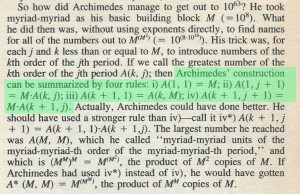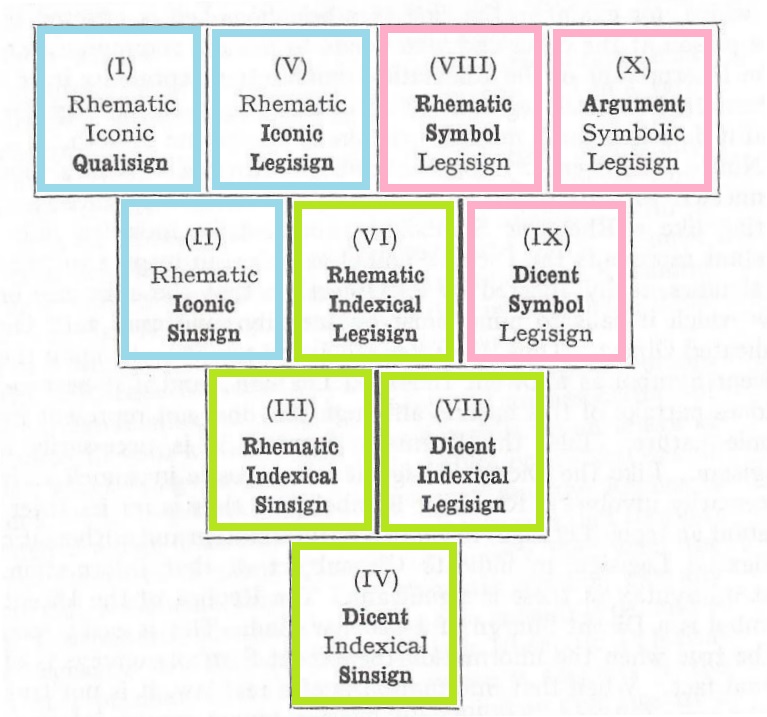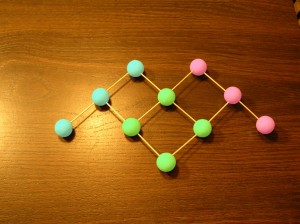In his essay, The Sand Reckoner, Archimedes specified a system of nomenclature for large numbers. ( The greek title is yammites which is simply, “sand”. Interestingly, Liddel and Scott’s Intermediate Greek Lexicon includes yammakosioi, a “sand-hundred”, stated to be a “comic word”, presumably like “gazillion’, indicating a “countless multitude”. )
The Greeks had names for ten, hundred, thousand, and ten thousand, which was the myriad, and by composition had expressions for numbers up to the myriad myriad, which Archimedes used as the base of his system, and which we designate here by M. He called the numbers from 1 to M the first order of numbers, and using M as a unit of the second order, counted from M to M2, which became the unit of the third order. Continuing in this way, he postulated M such orders, counting up to MM.
He then called this the 1st period of orders, and continued with the 1st order of the second period counting in units of MM up to MM+1. Then M orders of the 2nd period count up to M2M, and finally the Mth period counts to MM2, which was the limit of his system.
Note that the orders of each period all count from 1 to M, so that the M periods of M orders comprise M2 orders all together, accounting for M2 factors of M.
This system of Archimedes is considered as something of an oddball, but it is actually familar to us in the form of our number naming system, if we take M to stand for “million” instead of “myriad myriad”.
Note that “million” derives from the Italian, “millione” meaning “grand thousand”, i.e. a thousand thousand, so our million corresponds directly to the myriad myriad, or “grand myriad”, even though different in value. Then we see that the “long scale” or European system, which uses a million as a multiplier, starts off just like Archimedes’ system, with the numbers of the second order counting by millions up to one billion, the unit of the third order numbers, which count up to one trillion, and so on.
Well then, how well does our nomenclature keep up with Archimedes in this analogy? The first sign of trouble ahead comes at the end of the 1000th order, when we hit one milliatillion, as this is where the nomenclature plays its last card. Still, we make out OK up to the end of the first period, where the one millionth order ends at one milliamilliatillion.
Now in the Archimedian system, we “start fresh” at each period, so we can specify an order of each period between one and one million and get any power of a million up to a million million. In the modern “long scale” we are stuck with concatenating an extra “milliamillia” for each period, and the unit of the first order of the 5th period is
one milliamilliamilliamilliamilliamilliamilliamilliamilliamilliatillion
( I’ve been using the site: The English name of a number, for these values. Set “power of ten” and “European ruleset” . )
So I think Archimedes wins the point. But could we extend the modern nomenclature to accommodate the Archimedean scheme? This would mean extending it to one million periods, and in fact this can very easily be done.
Just as the suffix “-tillion” indicates powers of one million, we can introduce the suffix “-zillion” to indicate powers of milliamilliatillion, or one million to the one millionth power. Each period introduces a factor of one zillion, so we can call the largest number of the second period one bazillion, in analogy to one billion as a million million ( in the “long scale” ) . Then we march through trazillion, quatrazillion, etc. in one to one correspondence with the orders of the first period, and the largest number of the millionth period, which is the limit of this scheme, is one miliamilliazillion. So there you are.
RUDY RUCKER’S “SUGGESTION”
Rudy Rucker makes some cursory but pithy comments in his 1983 book, INFINITY AND THE MIND. Here is an excerpt from my copy of the Bantam paperback edition.
Regarding the highlighted recursion rules, there are two mistakes. The first is a trivial error in ii) A(1, j+1 ) = M*A(k,j) which evidently s/b ii) A(1,j+1) = M*A(1,j), noting that rule iv covers values of k > 1, ( although it allows k+1 = M+1, which we shall overlook.)
The second error is not so easily dismissed. This is in iii) A(k+1,1) = A(k,m), which s/b iii) A(k+1,1) = M*A(k,M), since A(k,j) is the GREATEST value of the jth order of the kth period, and A(k,M) is the UNIT of A(k+1,1) . I checked this out with actual recursive definitions in “bc” on cygwin, for low base values such as 3,4, and 5, so don’t doubt me!
But what about this? I think it’s all explained by the author’s suggested improvement using rule iv*) . The modified rule, with the other rules as stated ( except for the above cited trivial correction ) does produce values of A(M,M) = M^M^M, as claimed, so it would appear that the original formulas were reverse engineered from the “improved” version.
The machinations of the latter can be easily discerned. The “highest values of the orders of the periods” ( inconsistently so called ) progess as follows:
M M2 … MM
MM M2M … MM2
MM2 M2M2 … MM3
…
MM(M-1) M2M(M-1) … MMM
… but this seems to bear very little relation to Archimedes’ scheme, which is based on simple enumeration. The multiplier value of M comes from counting 1 thru M in each order of each period, and this is the defining principle. It is the unit of the enumeration that changes, and the numbers of all the orders are the same, namely 1 thru M.
But nevertheless ! … there is a connection, and Rucker’s modified formula is contained in the Archimedean scheme. Note the very suggestive sequence of A(k,M) = MMk , where k=1 corresponds to the end of the Mth order, and k=2 corresponds to the end of the Mth period. The suggestion is namely that we consider orders and periods to be the 1st and 2nd levels of a generalized sequence of nth level periods.
Furthermore, each row comprises successive powers of the first element, as specified by rule iv*). So Rucker’s scheme gives a summary of the values reached by the jth element of the kth-level period, j and k passing from 1 to M.
Note that it would require a recursive function with M arguments to specify M levels of periods in a direct continuation of the original scheme.
It seems that Rucker must have used this reasoning, or some form of it, to derive his function, but his remarks that Archimedes “could” and “should” have made a similar specification remain puzzling.







